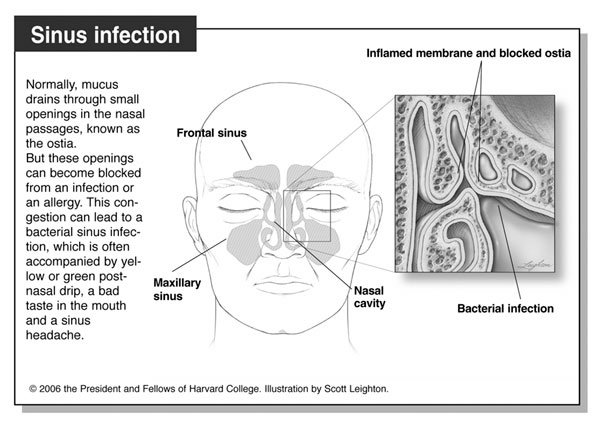Q: I’ve had several painful sinus infections in the past year.
Is there anything I can do to help prevent them?
By The Faculty of Harvard Medical School
Q: I’ve had several painful sinus infections in the past year. Is there anything I can do to help prevent them?
A: Yes, you can help prevent sinus infections with a simple, inexpensive technique called nasal irrigation. Basically, it involves squirting salty water up your nose.
The sinuses are air chambers in the bones behind your cheeks, eyebrows and jaw (see illustration). They make mucus, which cleans bacteria and other particles out of the air you breathe. Normally, mucus collects in the sinuses and drains into the nasal passages. But if you have a cold or allergy attack, your sinuses may swell and become unable to drain. This causes a stuffy nose. It also can cause bacteria or mold to build up in the sinuses, and a sinus infection, or sinusitis, can result. Other symptoms of a sinus infection include fever and pain or pressure in the forehead, cheeks or between the eyes.
Nasal irrigation helps for two reasons. First, by washing junk out of the nasal passages, it makes breathing through the nose easier. Second, it washes out excess mucus and other debris, such as bacteria, mold, dust and other irritants, which can make you more likely to develop a sinus infection. At least eight studies have shown that nasal irrigation really helps, both for improving symptoms and helping people cut down on their use of nasal spray and antibiotics. Both are common treatment for sinus infections.
To irrigate your nose, all you really need is a bulb syringe – a common device used to clean newborn infants’ noses that looks like a cross between a light bulb and a turkey baster. A bulb syringe costs under $5; some drugstores and most medical-supply stores carry them. Stand in front of a sink and follow these steps:
1. Fill an 8-ounce glass with lukewarm tap water.
2. Stir in approximately 1 tsp. of table salt. The exact amount is not critical; just make it slightly salty to taste.
3. Fill the bulb entirely with the saltwater solution.
4. Lean over the sink, and with your head bowed slightly, insert the tip of the syringe just inside your nostril.
5. Gently squeeze the bulb. The solution will run up into your nose and then drain back out the nostril into the sink. Sometimes the water may run to the back of the nose and drain out the opposite nostril or the mouth – that’s not a problem. It’s also OK if some of the water drains into the back of your mouth – just spit it out.
6. Refill the bulb and irrigate the other nostril the same way. It’s best to use one full bulb for each side of the nose.
You know you’re irrigating correctly if mucus is flushed out the front of the nose. You may need to blow your nose afterward to clear the loosened mucus. When you’re done, you’ll notice you can breathe much more easily through your nose.
Nasal irrigation may feel unusual the first time you try it – kind of like getting water in your nose when you jumped into a pool as a kid. But once you get the hang of it, it’s very soothing.
Most of the water goes into your nasal cavity and then flows right out. Water does not usually enter your sinuses. But it’s not a problem if a little water does since it just drains back out.
There’s no need to use purified or sterile water, because regular tap water is clean enough. And regular table salt works fine. Some people find nasal irrigation stings a little. You may find that adding a little extra salt or 1/2 tsp. of baking soda (in addition to the salt) may help.
How often should you irrigate? Twice a day, after brushing your teeth, is a good starting point. But it’s fine to do it more often, since there are few or no side effects. Many people rinse their nose only when mucus builds up and congestion develops, such as during allergy season or an infection. Once you get into the habit, you will probably agree with many others that this simple technique provides tremendous relief from sinusitis symptoms and reduces the frequency of infections.
Submit questions to the Harvard Medical School Adviser at www.health.harvard.edu/adviser. Unfortunately, personal responses are not possible.













